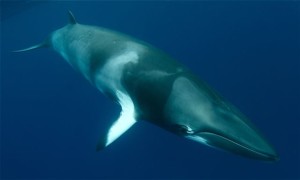Minke whales are members of the baleen whale family. Baleen whales are also referred to as the ‘great whales’, and are tooth-less cetaceans who use baleen plates to filter their food from the water. Dwarf Minkes are the smallest of the baleen whales; as adults, they measure just under 8 meterslong, and weigh between 5 – 6 tons.
A Special Kind of Minke
Until recently it was believed that there was a single variable species of minke whale that inhabited the oceans around the world. However, in the mid 1980s, a smaller, more interactive kind of minke began to regularly approach boats and swimmers in the waters of the northern Great Barrier Reef. These unique & friendly cetaceans were soon recognized as a distinct form of minke, and are now known as Dwarf Minke whales.
Dwarf minkes are found only in the Southern Hemisphere and have been sighted in both the tropical & sub-arctic waters waters off of South Africa, Australia, New Zealand, New Caledonia, and the east coast of South America.
Minkes Are Rorquals
Rorquals form the largest group of baleen whales, with nine species including minkes. Rorquals are slender and streamlined cetaceans with narrow, elongated flippers and a dorsal fin situated far back on the body. Dwarf minkes are particularly sleek, elegant, & agile, and can jump from the water like dolphins. Because of their diminutive size, they use speed to avoid predators.
Dwarf minkes are uniquely patterned with asymmetric and often beautiful markings on the left & right sides of their bodies. They have white shoulders which extend to their flipper base, with a dark-grey tip on their flippers. They display a dark band on their necks between the end of the mouth and the flipper, which extends down each side of their throat. These dark throat patches can be seen clearly when the minke rolls to show the underside of their body. Each dwarf minke appears to have been hand-painted like an exquisite piece of artwork.
How They Breathe and Eat
Minke whales breathe from a set of paired nostrils (blowholes) on the top of their head. Dwarf minke whales usually surface for a quick breath with a smooth arching of the back, then dive for periods up to 12 minutes.
In order to eat, dwarf minkes filter clouds of tiny crustaceans and fish through 215 – 325 pairs of baleen plates that hang from either side of the roof of their mouths. They feed by expanding their pleated throats to take in mouthfuls of water containing the krill and small fish. When they close their mouths and contract their throats, the krill & fish are trapped and swallowed.
Dwarf minke whales have never been seen feeding on the northern Great Barrier Reef, however it is entirely possible that while in the tropics they feed opportunistically in the open ocean.
Blissful Unions
Between March and October, these small lovely whales appear to migrate to the offshore northern waters of the Great Barrier Reef. The highest concentration of dwarf minkes congregate on the Barrier Reef during the Australian winter (June & July), where they willingly approach boats and interact with snorkelers. Swimmers and divers have been experiencing intimate in-water encounters with some of the more inquisitive whales for the past 20 years.
From late spring through summer, most of the sightings of dwarf minkes are in the colder waters to the south of Australia & New Zealand.

